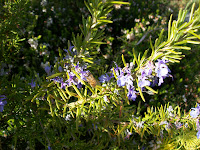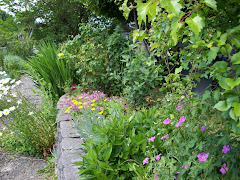 Today was the first time I've seen honey bees this year. With all the news about declining honey bee populations worldwide, I was sure glad to see them! The two bees were collecting pollen from my rosemary blooms. They didn't seem to mind me taking a few shots of them.
Today was the first time I've seen honey bees this year. With all the news about declining honey bee populations worldwide, I was sure glad to see them! The two bees were collecting pollen from my rosemary blooms. They didn't seem to mind me taking a few shots of them.After admiring the two bees that visited my yard, I decided to do some internet research about honey bees. There are a number of factors contributing to their decline. In almost every state, hives are succombing to colony collapse disorder, die-off characterized by adult bees leaving the hive. Possible causes include pesticides, parasites, and nutrition. One good site to get local information about honey bees is the Washington State Beekeepers Association.
I am not sure how much small gardeners can help, but I think keeping a variety of plants and not using pesticides is a good start.


